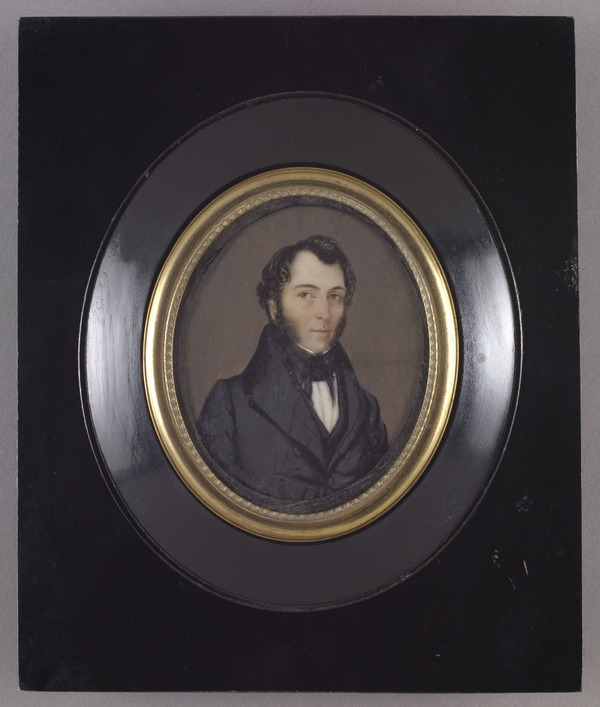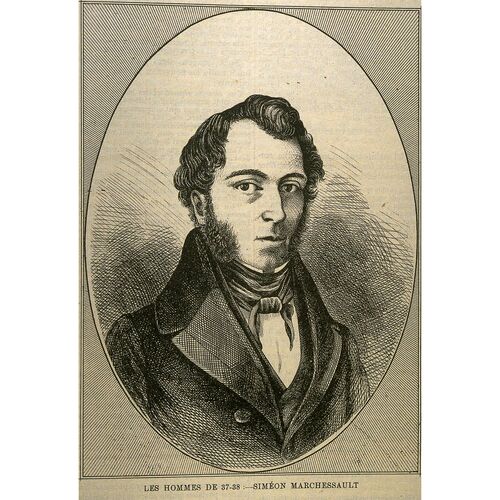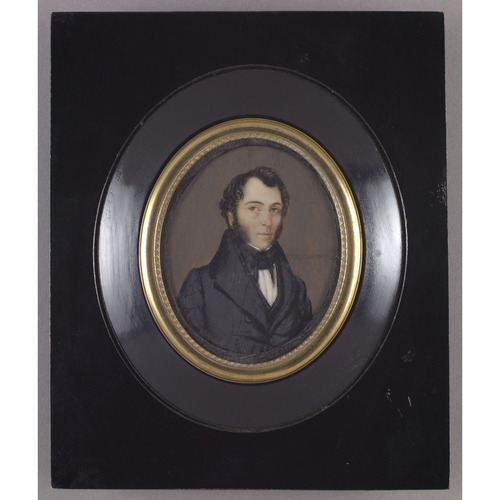MARCHESSEAULT (Marchessault), SIMÉON (baptized Abraham-Siméon), teacher, office holder, and Patriote; b. 18 Feb. 1806 in Saint-Ours, Lower Canada, and baptized the same day at Saint-Antoine-sur-Richelieu, son of Abraham-François Marchessaut, a master blacksmith, and Émélie Cormier; d. 8 July 1855 in Saint-Hyacinthe, Lower Canada.
Siméon Marchesseault was a descendant of Acadians on both sides of his family. His ancestor Jean Marchesseau had come to Acadia from Saint-Jary, near La Rochelle, France, probably around the beginning of the 18th century. Apparently Jean’s grandson Christophe Marchessaut, who was Siméon’s grandfather, had settled at Saint-Antoine-sur-Richelieu in the province of Quebec by 1770. Siméon Marchesseault’s mother was from a family whose forebear Robert Cormier had begun living at Port-Royal (Annapolis Royal, N.S.) in 1654. Cormier’s descendants had been driven from Acadia by the British at the time of the deportation.
According to Laurent-Olivier David* and Ægidius Fauteux*, Siméon Marchesseault reportedly studied for some years at the Petit Séminaire de Montréal but his name is not on the list of students at that institution; it does, however, figure in the record of those at the Collège de Saint-Hyacinthe for the year 1821–22. After his schooling Marchesseault went to work as a teacher at Saint-Denis, on the Richelieu, and then settled in the neighbouring village of Saint-Charles-sur-Richelieu, where he also taught, as did Jean-Philippe Boucher-Belleville*. On 22 Sept. 1829 he married Judith Morin there; they were to have three sons and five daughters. Marchesseault apparently found it difficult to support his family, for by 1837 he had abandoned his trade to assume the office of bailiff to the Court of King’s Bench in the district of Montreal.
Intelligent, fervent, and energetic, Marchesseault had lost no time in joining the ranks of Louis-Joseph Papineau* and throwing himself into the constitutional struggle. With the assurance born of his education, experience as a teacher, and gifts as a speaker, he enjoyed a degree of “power over the people,” according to David. He became one of the most vigorous defenders of the Patriote cause. In 1834, at a meeting held at Saint-Denis to protest against the Legislative Council’s rejection of the 92 Resolutions, he was appointed a member of a committee “to promote the general welfare of the province.” Two years later, he took part in the Saint-Jean-Baptiste celebrations in that village, during which a monument was dedicated to Louis Marcoux, a Patriote shot by members of the English party in the election campaign at William Henry (Sorel) in 1834; on this occasion he delivered a speech expressing republican sentiments.
Although he did not belong to a liberal profession, Marchesseault was one of the most influential Patriotes at Saint-Charles-sur-Richelieu in 1837. He attended all the large meetings in Richelieu County before the rebellion, roused the people against the government, and incited them to revolt by his fiery words. At the Saint-Ours meeting on 7 May, after Wolfred Nelson* and Cyrille-Hector-Octave Côté* had spoken, he condemned Lord John Russell’s resolutions, terming them a “violation of the social contract,” and expressed regret that French Canadians had not sided with the Americans in 1775. On 23 October he received at his home the delegates to the Assemblée des Six Comtés who had come together to draft its stirring resolutions; during the well-known meeting that followed he supported the resolution to create branches of the Fils de la Liberté in the six counties; he himself soon set up one in his village. On 5 November he protested at the doors of the church in Saint-Charles-sur-Richelieu against the first pastoral letter of the bishop of Montreal, Jean-Jacques Lartigue*, which called for obedience and submission to authority, and he urged his compatriots to continue to foment unrest.
When the rebellion broke out, Marchesseault was one of the first to take up arms. On 18 Nov. 1837, with the help of Thomas Storrow Brown*, Henri-Alphonse Gauvin, and Rodolphe Des Rivières*, three Patriote leaders who had come from Montreal to dodge warrants of arrest issued two days earlier, he set up a fortified camp at Saint-Charles-sur-Richelieu. The next day Marchesseault was appointed captain and became an aide-de-camp to General Brown. He took part in the battle at Saint-Denis on 23 November and in the one at Saint-Charles-sur-Richelieu two days later.
In the second battle he distinguished himself by taking over command after Brown left for Saint-Denis. With the energy born of despair he fought alongside some 100 men against three times as many well-trained troops under Lieutenant-Colonel George Augustus Wetherall*. According to Edward Alexander Theller, he succeeded in bringing down the horse Wetherall was riding. But the camp was soon surrounded, cannon-balls shattered the ramparts, and Marchesseault had to flee to escape certain massacre. He spurred his horse into the midst of the British soldiers, and as he jumped over the fortifications narrowly escaped death from a bullet that penetrated a packet of papers in his jacket pocket. He then made for the village. To avoid being recognized, he mingled with the soldiers who had set fire to his house; through this ruse he managed to enter his dwelling, hunt out important documents, and then run to his stable and rescue his animals from the flames; finally, to evade pursuit by the volunteers he hid in the woods.
On 1 Dec. 1837 Marchesseault set out for the United States with Nelson and a few other Patriotes. But, separated from several of his companions following an alarm, he lost his way in the woods, and on 7 December, along with Boucher-Belleville, Desrivières, Timothée Kimber, and one or two other comrades who had remained with him, was arrested at Bedford, near the American border. He was imprisoned in Fort Lennox on Île aux Noix, and then transferred on 12 December to the jail at Montreal, with Nelson, Desrivières, Gauvin, and Robert-Shore-Milnes Bouchette*. On 26 June 1838, with seven compatriots, he agreed to sign a confession of guilt in return for the amnesty granted to the other political prisoners. Two days later, by a proclamation issued by Lord Durham [Lambton*], he was condemned to exile. On 4 July he sailed on the frigate Vestal for Bermuda, where he arrived on 28 July.
Marchesseault was set free on 26 Oct. 1838 and went to the United States. Upon his arrival on 9 November he made his way towards the Canadian border, and stayed in turn at Swanton, Vt, Champlain, N.Y., and Burlington, Vt. From this last place he wrote to the attorney general, Charles Richard Ogden*, for permission to return to Lower Canada. But Ogden bluntly turned him down, fearing that he would again stir up trouble.
Meanwhile Marchesseault led a wretched existence. To keep body and soul together, he took on all kinds of jobs. At one point he spent a month ironing musk-rat skins at a Swanton fur merchant’s establishment. In August 1840 he opened a grocery store with the help of a Burlington merchant who lent him 30 dollars’ worth of merchandise, but his business yielded little profit and he soon had to liquidate it. When he had no work he engaged in smuggling; this activity led to his crossing the border into the Richelieu valley, where he was able to meet his family in secret.
In October 1840 Marchesseault was allowed to return permanently to Lower Canada. Soon after, he settled with his wife and children at Saint-Hyacinthe, where he once again carried out the duties of a bailiff. He died there on 8 July 1855, at the age of 49.
It was as a Patriote that Siméon Marchesseault became well known. At the time of the rebellion he had made his mark by his bravery and coolness on the field of battle, and he had displayed his sense of honour by accepting exile. Even though relegated to the ranks of the defeated, he could take pride that he had been one of those unafraid to take up arms in the endeavour to liberate the French Canadian people from British oppression in Lower Canada in 1837.
Siméon Marchesseault corresponded on a regular basis with his family and relatives while incarcerated in the Montreal jail, during his exile in Bermuda, and when he was in the United States after his release. Most of his letters are in the Siméon Marchessault papers which form part of the Collection Montarville Boucher de la Bruère (0032) at the ASTR; these papers also contain his request for compensation for the damages suffered as a result of the burning of his house at Saint-Charles-sur-Richelieu. Two of Marchesseault’s letters are held by the ANQ, one to René-Auguste-Richard Hubert, dated 7 Sept. 1838, describing the condition of the Patriotes exiled to Bermuda (ANQ-M, P1000-34-805), and the other to his wife, dated 6 Dec. 1838 (ANQ-Q, E17/36, no.2873).
Montarville Boucher de La Bruère published several of Marchesseault’s letters in “Un héros maskoutain de l’épopée canadienne, 1837–1838: les lettres de Siméon Marchesseault,” Le Clairon (Saint-Hyacinthe, Qué.), 14 mars 1930: 1, 5, 8. Others were printed in “Documents inédits,” Yvon Thériault, édit., RHAF, 17 (1963–64): 107–12, 424–32.
ANQ-M, CE1-3, 18 févr. 1806; CE2-1, 11 juill. 1855; CE2-10, 22 sept. 1829; CE3-12, 16 janv. 1804. ANQ-Q, E17/9, nos.345–46, 352, 355; E17/14, no.844; E17/15, no.862; E17/22, nos.1485–86; E17/37, no.2983; E17/40, no.3206a; E17/51, nos.4106, 4137, 4145. BVM-G, Fonds Ægidius Fauteux, notes compilées par Ægidius Fauteux sur les patriotes de 1837–1838 dont les noms commencent par la lettre M, carton 7. PAC, MG 30, D1, 20: 315–19. [L.-J.-]A. Papineau, Journal d’un Fils de la liberté, réfugié aux États-Unis, par suite de l’insurrection canadienne, en 1837 (2v. parus, Montréal, 1972– ), 1: 54. E. A. Theller, Canada in 1837–38 . . . (2v., Philadelphia and New York, 1841). Le Courrier de Saint-Hyacinthe (Saint-Hyacinthe), 10 juill. 1855. La Minerve, 27 mars 1834; 4 juill. 1836; 11 mai, 30 oct., 13 nov. 1837. Fauteux, Patriotes, 313–15. Lefebvre, Le Canada, l’Amérique, 187. Allaire, Hist. de Saint-Denis-sur-Richelieu, 433. Bona Arsenault, Histoire et généalogie des Acadiens (éd. rév., 6v., [Montréal, 1978]). Chaussé, Jean-Jacques Lartigue. Choquette, Hist. du séminaire de Saint-Hyacinthe, 2; Histoire de la ville de Saint-Hyacinthe (Saint-Hyacinthe, 1930), 124, 368. Azarie Couillard-Després, Histoire de la seigneurie de Saint-Ours (2v., Montréal, 1915–17), 2: 227. L.-O. David, Les gerbes canadiennes (Montréal, 1921), 174; Patriotes, 103–4. G.-A. Dejordy, Généalogies des principales familles du Richelieu (2v., Arthabaska, Qué., 1927), 2: 106. Filteau, Hist. des Patriotes (1975). Labarrère-Paulé, Les instituteurs laïques, 48. Laurin, Girouard & les Patriotes, 84. Ouellet, Bas-Canada. Rumilly, Papineau et son temps. Mason Wade, Les canadiens français, de 1760 à nos jours, Adrien Venne et Francis Dufau-Labeyrie, trad. (2e éd., 2v., Ottawa, 1966), 1: 182. L.-O. David, “Les hommes de 37–38: Siméon Marchesseault,” L’Opinion publique (Montréal), 21 juin 1877: 289.
Cite This Article
Michel de Lorimier, “MARCHESSEAULT (Marchessault), SIMÉON (baptized Abraham-Siméon),” in Dictionary of Canadian Biography, vol. 8, University of Toronto/Université Laval, 2003–, accessed April 26, 2025, https://www.biographi.ca/en/bio/marchesseault_simeon_8E.html.
The citation above shows the format for footnotes and endnotes according to the Chicago manual of style (16th edition). Information to be used in other citation formats:
| Permalink: | https://www.biographi.ca/en/bio/marchesseault_simeon_8E.html |
| Author of Article: | Michel de Lorimier |
| Title of Article: | MARCHESSEAULT (Marchessault), SIMÉON (baptized Abraham-Siméon) |
| Publication Name: | Dictionary of Canadian Biography, vol. 8 |
| Publisher: | University of Toronto/Université Laval |
| Year of revision: | 1985 |
| Access Date: | April 26, 2025 |






